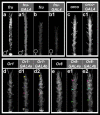Identification of Aedes aegypti cis-regulatory elements that promote gene expression in olfactory receptor neurons of distantly related dipteran insects
- PMID: 29996889
- PMCID: PMC6042464
- DOI: 10.1186/s13071-018-2982-6
Identification of Aedes aegypti cis-regulatory elements that promote gene expression in olfactory receptor neurons of distantly related dipteran insects
Abstract
Background: Sophisticated tools for manipulation of gene expression in select neurons, including neurons that regulate sexually dimorphic behaviors, are increasingly available for analysis of genetic model organisms. However, we lack comparable genetic tools for analysis of non-model organisms, including Aedes aegypti, a vector mosquito which displays sexually dimorphic behaviors that contribute to pathogen transmission. Formaldehyde-assisted isolation of regulatory elements followed by sequencing (FAIRE-seq) recently facilitated genome-wide discovery of putative A. aegypti cis-regulatory elements (CREs), many of which could be used to manipulate gene expression in mosquito neurons and other tissues. The goal of this investigation was to identify FAIRE DNA elements that promote gene expression in the olfactory system, a tissue of vector importance.
Results: Eight A. aegypti CREs that promote gene expression in antennal olfactory receptor neurons (ORNs) were identified in a Drosophila melanogaster transgenic reporter screen. Four CREs identified in the screen were cloned upstream of GAL4 in a transgenic construct that is compatible with transformation of a variety of insect species. These constructs, which contained FAIRE DNA elements associated with the A. aegypti odorant coreceptor (orco), odorant receptor 1 (Or1), odorant receptor 8 (Or8) and fruitless (fru) genes, were used for transformation of A. aegypti. Six A. aegypti strains, including strains displaying transgene expression in all ORNs, subsets of these neurons, or in a sex-specific fashion, were isolated. The CREs drove transgene expression in A. aegypti that corresponded to endogenous gene expression patterns of the orco, Or1, Or8 and fru genes in the mosquito antenna. CRE activity in A. aegypti was found to be comparable to that observed in D. melanogaster reporter assays.
Conclusions: These results provide further evidence that FAIRE-seq, which can be paired with D. melanogaster reporter screening to test FAIRE DNA element activity in select tissues, is a useful method for identification of mosquito cis-regulatory elements. These findings expand the genetic toolkit available for the study of Aedes neurobiology. Moreover, given that the CREs drive comparable olfactory neural expression in both A. aegypti and D. melanogaster, it is likely that they may function similarly in multiple dipteran insects, including other disease vector mosquito species.
Keywords: Aedes aegypti; Antenna; Dengue; Drosophila melanogaster; Enhancer; FAIRE; Mosquito; Neuron; Sensory; Zika.
Conflict of interest statement
Ethics approval and consent to participate
Not applicable.
Consent for publication
Not applicable.
Competing interests
The authors declare that they have no competing interests.
Publisher’s Note
Springer Nature remains neutral with regard to jurisdictional claims in published maps and institutional affiliations.
Figures



Similar articles
-
High-throughput cis-regulatory element discovery in the vector mosquito Aedes aegypti.BMC Genomics. 2016 May 10;17:341. doi: 10.1186/s12864-016-2468-x. BMC Genomics. 2016. PMID: 27161480 Free PMC article.
-
Chitosan/siRNA nanoparticle targeting demonstrates a requirement for single-minded during larval and pupal olfactory system development of the vector mosquito Aedes aegypti.BMC Dev Biol. 2014 Feb 19;14:9. doi: 10.1186/1471-213X-14-9. BMC Dev Biol. 2014. PMID: 24552425 Free PMC article.
-
Genomic organization and splicing evolution of the doublesex gene, a Drosophila regulator of sexual differentiation, in the dengue and yellow fever mosquito Aedes aegypti.BMC Evol Biol. 2011 Feb 10;11:41. doi: 10.1186/1471-2148-11-41. BMC Evol Biol. 2011. PMID: 21310052 Free PMC article.
-
Development and applications of transgenesis in the yellow fever mosquito, Aedes aegypti.Mol Biochem Parasitol. 2002 Apr 30;121(1):1-10. doi: 10.1016/s0166-6851(02)00028-2. Mol Biochem Parasitol. 2002. PMID: 11985858 Review.
-
Molecular tools to create new strains for mosquito sexing and vector control.Parasit Vectors. 2018 Dec 24;11(Suppl 2):645. doi: 10.1186/s13071-018-3209-6. Parasit Vectors. 2018. PMID: 30583736 Free PMC article. Review.
Cited by
-
Use of Insect Promoters in Genetic Engineering to Control Mosquito-Borne Diseases.Biomolecules. 2022 Dec 21;13(1):16. doi: 10.3390/biom13010016. Biomolecules. 2022. PMID: 36671401 Free PMC article. Review.
-
Conserved and novel enhancers in the Aedes aegypti single-minded locus recapitulate embryonic ventral midline gene expression.PLoS Genet. 2024 Apr 29;20(4):e1010891. doi: 10.1371/journal.pgen.1010891. eCollection 2024 Apr. PLoS Genet. 2024. PMID: 38683842 Free PMC article.
-
Chromatin Structure and Function in Mosquitoes.Front Genet. 2020 Dec 7;11:602949. doi: 10.3389/fgene.2020.602949. eCollection 2020. Front Genet. 2020. PMID: 33365050 Free PMC article. Review.
-
Identification of new Anopheles gambiae transcriptional enhancers using a cross-species prediction approach.Insect Mol Biol. 2021 Aug;30(4):410-419. doi: 10.1111/imb.12705. Epub 2021 Apr 27. Insect Mol Biol. 2021. PMID: 33866636 Free PMC article.
-
The regulatory genome of the malaria vector Anopheles gambiae: integrating chromatin accessibility and gene expression.NAR Genom Bioinform. 2021 Jan 20;3(1):lqaa113. doi: 10.1093/nargab/lqaa113. eCollection 2021 Mar. NAR Genom Bioinform. 2021. PMID: 33987532 Free PMC article.
References
-
- Centers for Disease Control and Prevention. Surveillance and control of Aedes aegypti and Aedes albopictus.http://www.cdc.gov/chikungunya/resources/vector-control.html (2016). Accessed May 2016.
MeSH terms
Substances
Grants and funding
LinkOut - more resources
Full Text Sources
Other Literature Sources
Molecular Biology Databases

